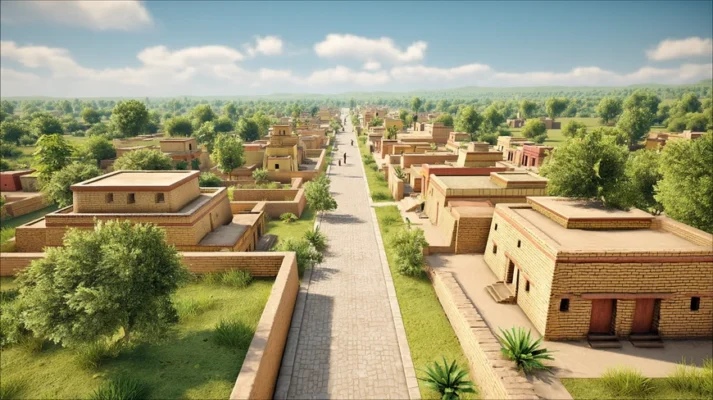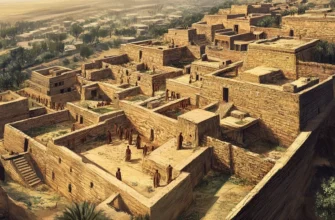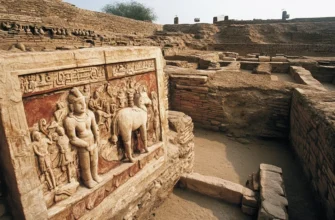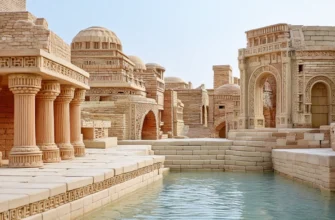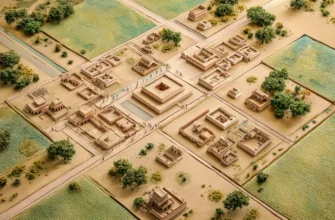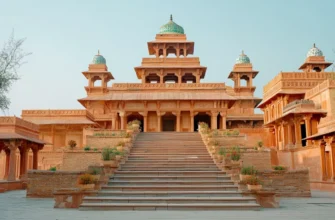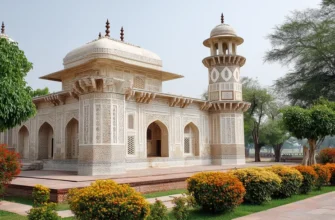Harappa is one of the main cities of the Indian civilization that existed in the 3rd–2nd millennium BC on the territory of modern Pakistan and India. This city became the first center of ancient culture discovered by archaeologists, which was named the “Harappan civilization.” It was well planned, with straight streets, fortified buildings, and a developed water supply and sewage system. The houses were built of fired bricks, and the city structure was divided into residential, administrative, and ritual areas. Harappa was a center of trade and crafts, its inhabitants were engaged in agriculture, cattle breeding, pottery, and active trade with Mesopotamia. Harappa seals with images of animals and religious symbols are well known, indicating the existence of a complex cult system. Around 1500 BC, the city fell into decline, probably due to climate change, natural disasters, or the invasion of the Aryans. Today, the ruins of Harappa are an important archaeological site that helps to uncover the mysteries of one of the world’s oldest civilizations.
Harappa played a key role in Indian civilization, being one of its largest and most developed centers. The city demonstrated a high level of urban planning, indicating the existence of organized state power and an effective administrative system. Harappa was an important trading hub, maintaining ties with Mesopotamia, Central Asia, and other regions. A developed sewage system, architectural solutions, and unique seals with images of symbols and animals indicate a high level of culture and social organization. The decline of the city marked the end of Indian civilization, but its legacy continues to influence the development of cultures in India and Pakistan.
History of discovery
Harappa was discovered in 1826 by British explorer Charles Mason, who was the first to report on the ancient ruins. However, real archaeological research only began in 1921 under the direction of John Marshall. During the excavations, the remains of a powerful urban civilization were discovered, including residential buildings, a complex water supply system, sewage system, seals with inscriptions, and artifacts that testify to a developed culture. The discovery of Harappa was one of the most important archaeological breakthroughs of the 20th century, allowing scientists to establish the existence of the previously unknown Indian civilization.
Archaeological excavations
Archaeological excavations in Harappa began in 1921 under the direction of John Marshall and became a real discovery for history. Researchers found the remains of a well-planned city with developed infrastructure, including streets paved with fired bricks, residential and administrative buildings, public wells, and a sewage system. Significant attention was drawn to seals with mysterious inscriptions, which are probably examples of an unknown script. Pottery, statuettes, jewelry, and other artifacts were also found, indicating a high level of craftsmanship and trade. Further excavations helped establish links between Harappa and Mesopotamia and other civilizations of the ancient world. Today, research continues, revealing new aspects of the life of the inhabitants of this unique city.
Main finds and their significance
Archaeological excavations in Harappa have uncovered many unique artifacts that have helped researchers reconstruct the life of the ancient Indian civilization. Among the main finds are seals with mysterious inscriptions and images of animals, which were probably used for trade, administrative records, or ritual purposes. They testify to the existence of a still undeciphered writing system and a developed system of communication.
The urban planning system, including level streets, public wells, drainage channels, and sewers, indicates a high level of engineering and social organization. The fired brick houses testify to the durability of building traditions.
Among the household items found are pottery, jewelry, bronze and copper tools, confirming the development of crafts and metallurgy. The female figurines found may depict a goddess of fertility, indicating the existence of religious cults.
These findings have helped establish that Harappa was a powerful economic, cultural, and administrative center, and that its civilization had achieved significant development long before other known ancient states.
Architecture and urban planning
The architecture and urban planning of Harappa testify to a high level of social organization and advanced engineering skills. The city was built according to a clear plan, divided into two main parts: a citadel located on a hill and a lower city where most of the population lived.
The streets of Harappa were well laid out, laid out at right angles, and paved with fired bricks. This ensured easy movement and an efficient drainage system. Residential buildings were built of sturdy fired bricks, often had several floors, inner courtyards, and special water reservoirs.
A distinctive feature of Harappa was its developed water supply and sewage system. Public wells provided the city with clean water, and underground drainage channels carried away sewage, indicating a concern for sanitation.
Some public buildings, such as large granaries, indicate centralized management of food supplies. The city also had ritual structures, which were probably used for religious ceremonies.
Such complex and well-thought-out urban planning makes Harappa one of the best examples of advanced urbanism in the ancient world.
City structure
The structure of Harappa was carefully planned and met high standards of urban construction. The city was divided into two main parts: the citadel and the lower city.
The citadel, located on a hill, was the administrative and religious center. It contained large public buildings such as granaries, water reservoirs, and possibly religious buildings. The citadel could also serve as a defensive fortress in times of danger.
The lower town was a residential area where most of the population lived. It had a well-planned network of straight streets that intersected at right angles, creating quarters with residential and public buildings. The houses, built of fired bricks, often had several floors, inner courtyards, and wells.
An important part of the city’s structure was a developed sewage system. Street drainage channels and underground drains provided sanitation and water disposal.
The city also had public wells, baths, and markets, indicating a high level of organization in the lives of its inhabitants. The structure of Harappa demonstrates a unique urban system that was ahead of many other ancient civilizations.
Fortress and residential quarters
The fortress and residential quarters of Harappa had a clearly defined role in the life of the city. The fortress, located on a hill in the center of the city, served not only defensive but also administrative and religious functions. It was protected by strong walls built of large bricks and served as a place for important state institutions and religious buildings. The fortress had large granaries and other public buildings, indicating the importance of centralized storage of resources. It is likely that the rulers and their administration were located in this part of the city.
The residential quarters were located in the lower part of the city and were built of fired bricks, which ensured the durability of the buildings. The streets in these areas had a clear layout: they intersected at right angles, forming quarters with limited plots for each house. Houses in residential areas often had several floors, courtyards, and special rooms for storing water and food. The inner courtyards provided privacy and were also used for household chores.
Thus, the fortress and residential quarters of Harappa indicate the complex social and economic structure of the city, where each district had its own purpose and was thoughtfully integrated into the overall urban system.
Streets and their layout
The streets of Harappa were one of the most striking features of urban planning and reflected the high level of organization of the inhabitants’ lives. The city was built with a clear and logical plan: streets intersected at right angles, forming rectangular blocks.
This gave the streets of Harappa a certain geometric order that differed from the chaotic development of many other ancient cities.
The streets of the city were paved with fired bricks, which ensured their durability and ease of movement. This was a significant achievement for that time, as it allowed for effective traffic management and ensured cleanliness and order. The streets were wide enough to allow for easy transportation of goods and maintenance of city buildings.
One of the distinctive features of Harappa’s street system was its advanced drainage system. Water channels ran along the streets, indicating a high level of attention to sanitation. Water drained after rain or domestic use did not flood the streets, keeping the city clean and functional.
This layout shows considerable attention to the organization of urban space and improving the quality of life of residents, making Harappa one of the first civilizations.
Engineering structures
The engineering structures of Harappa were among the most impressive achievements of Indian civilization and testified to the high level of technological development at that time. One of the most impressive features was the water supply and sewage systems, which allowed the city to remain clean and provide its inhabitants with water.
Water supply system
The city had many public wells that provided water for the inhabitants, especially in the central areas of the city. Wells were often located within residential areas or near important public buildings. This allowed water to be stored in sufficient quantities for domestic use.
Sewerage
One of Harappa’s greatest achievements was its advanced sewerage system. Underground channels running along the streets collected wastewater from houses and carried it to large drainage systems outside the city.
The channels were lined with fired bricks and had special openings for cleaning, which ensured their long-term functioning. Thanks to this drainage system, Harappa was able to maintain high hygiene standards and avoid flooding during rains.
Buildings and materials
Harappa’s construction technologies were also highly developed. The main building material was fired brick, which made the structures strong and durable. The use of this material for the construction of residential buildings, public buildings, walls, and even warehouses testifies to the high technological skills of the architects of that time.
These engineering achievements made Harappa one of the most innovative cities of its time and greatly facilitated the lives of its inhabitants.
Culture and society
The culture and society of Harappa were highly developed and reflected the complexity of their civilization. It had a rich cultural heritage that encompassed art, religion, crafts, and economic organization.
Religion and art
The Harappa civilization left behind numerous artifacts that point to a deep religious life. One of the most famous are statuettes, which probably depict deities or symbols of religious beliefs. One such statuette is the “Pura Sculpture,” which may be a representation of the goddess of fertility. Some scholars believe that the Harappans believed in divine forces associated with natural phenomena such as water, earth, and animals. This can also be traced through the seals found with images of animals such as elephants, tigers, and bulls, which may have had cult significance.
The art of Harappa included various crafts such as pottery, metallurgy, weaving, and the manufacture of jewelry and tableware. Their pottery was of very high quality, with bright ornamentation, and the necklaces and pearls found testify to a high level of jewelry making.
Social structure
The Harappa society probably had a complex social structure, but specific details about its political organization remain unclear due to the lack of written sources. However, archaeological finds indicate the existence of different social classes, from rulers and priests to craftsmen and peasants.
Administrative buildings, large grain storage facilities, and complex resource management systems indicate centralized power.
The trade system was well developed, and the city actively traded with other cultures, particularly Mesopotamia. It has been noted that Harappa had access to a variety of natural resources, such as metal, precious stones, and spices, which were used not only for domestic needs but also for the manufacture of goods for export.
Life and economy
The main occupations of the inhabitants of Harappa were agriculture, cattle breeding, and crafts. They grew wheat, barley, and cotton, and raised livestock, including cows and sheep. Trade was an important part of the city’s economy. Thanks to its strategic location, Harappa was part of a large trade network connecting India with Mesopotamia and other regions. They exchanged agricultural products, metal goods, textiles, and other goods.
Thus, the culture and society of Harappa were highly organized, allowing the city to flourish and leave an impressive legacy for future generations.
Economy and trade
The economy and trade of Harappa were the main drivers of this civilization’s development and largely determined its economic success. The city was an important trade and economic center that maintained close ties with other great civilizations of the time, particularly Mesopotamia, Iran, and Central Asia.
Agriculture
Agriculture was the basis of Harappa’s economy. The city was located in the fertile valley of the Indus River, which allowed its inhabitants to successfully engage in farming. The main crops were wheat, barley, cotton, peas, and rice. Agriculture was based on high agronomic standards, including the use of irrigation systems that allowed for efficient land cultivation. The water supply and sewage systems also helped maintain soil fertility and provide water for crops.
Livestock
Livestock was also very important to the economy of Harappa. The city’s inhabitants raised cattle, including cows, sheep, goats, and buffalo. Animals were used not only for meat and milk, but also for plowing fields, which helped increase crop yields.
Leatherworking was also well developed, as animal skins were used to make clothing, utensils, and other household items.
Crafts
Crafts in Harappa were well developed, allowing the city to not only meet its internal needs but also produce goods for trade. The manufacture of tableware, jewelry, textiles, metal products, and seals became an important part of the economy. The most significant crafts were pottery, metallurgy (the manufacture of copper, bronze, and gold products), and weaving, particularly cotton fabrics.
Trade
Trade was an important part of the Harappa economy and was both domestic and international in nature. Trade routes connected Harappa with Mesopotamia, Persia, Central Asia, and even regions of the Southeast.
The people of Harappa actively traded agricultural products, metalwork, textiles, and cotton with other cultures. The city had a high level of trade development thanks to the use of seals to mark goods, which allowed for control over the flow of goods.
The city also developed maritime trade through ports located on the coast, allowing them to exchange goods with other coastal civilizations.
Thanks to well-organized trade and diverse crafts, Harappa flourished, becoming a powerful economic and cultural center of its time.
Religion and art
Religion and art in Harappa reflect the deep beliefs and high level of cultural development of this civilization, although many aspects of their religious practices and artistic traditions remain a mystery due to the lack of clearly deciphered written sources.
Religion
The religion of Harappa was closely linked to natural phenomena and life cycles, such as the fertility of the land, water, and animals. Numerous statuettes have been found in archaeological excavations, which probably depicted deities or symbols of religious beliefs. One of the most famous is the “Pura” statuette, depicting a figure resembling a woman with distinctive features, possibly a goddess of fertility or motherhood. Such a statue testifies to the reverence for deities associated with the fertility of the land and animals, which are important aspects of an agricultural civilization.
Seals with animals found during excavations often contain images of sacred animals such as bulls, elephants, and tigers, which may indicate religious rituals associated with animals or their symbolism. Other seals and artifacts may indicate worship of water, as well as the existence of sacred sites or ritual practices carried out in temples or specially designated areas.
Some researchers also believe that the Harappans had concepts of reincarnation and ancestor worship, although specific religious practices remain a subject of debate.
Art
The art of the Harappans was remarkably diverse and of high quality. One of the most striking achievements was the production of figurines made of ceramic, bronze, and stone. Some of these figurines depicted humans, animals, and deities, displaying skill in detail and expression.
For example, the famous statuettes of dancing girls or sacred animals indicate a developed art of sculpture.
Another important part of art was painted seals depicting various symbols, scenes from life and animals, as well as probably ritual images. The seals were made of hard stone or clay and were used to mark goods and documentation in trade. These seals also served as symbols of religious beliefs and were of great importance in the administrative life of the city.
Pottery in Harappa was of high quality, often featuring intricate ornamentation and geometric patterns. Many pottery items were used for domestic purposes, such as tableware, but objects serving ritual purposes have also been found.
Harappa art also included jewelry made from precious metals and stones. Strings of pearls, stones, and metal were woven together, and elaborate jewelry such as necklaces, bracelets, and rings were made. This art may also have been indicative of social status and religious beliefs.
Thus, religion and art in Harappa were closely linked, and together they created a rich cultural context in which religious practices were intertwined with everyday life and trade.
The decline of the city
The decline of Harappa is one of the greatest mysteries of archaeology. Although the exact reasons for the city’s decline are still unknown, researchers have put forward several theories that may explain this process.
Climate change
One of the main reasons for the decline of Harappa is believed to be climate change. A drop in the water level of the Indus River and general climate change could have led to drought and worsening conditions for agriculture. This could have caused food shortages, which affected the city’s economy and social stability.
Changes in the riverbed
Another theory is that changes in the Indus River bed could have seriously disrupted the irrigation system, which was important for agriculture. If the river changed its course or its level dropped, this could have led to problems with water supply and irrigation, which in turn would have led to economic difficulties and a decline in population.
Internal social and political changes
There is also a theory that social and political conflicts within society could have caused the decline of Harappa. With the development of trade and technology, population growth, and changes in the social structure, internal conflicts could have arisen, leading to political instability.
Attacks by external enemies
Some researchers suggest that external attacks may also have been a factor contributing to the decline. However, the existence of large-scale attacks or destruction has not yet been confirmed by archaeological data. Therefore, the role of external enemies in the decline of Harappa remains uncertain.
Problems with water supply and sewage
Another hypothesis is that over time, the city’s water supply and sewage systems may have deteriorated. If these engineering structures were unable to function due to wear and tear or other factors, this could have led to serious hygiene problems that negatively affected the population.
Despite numerous theories, the decline of Harappa was probably caused by a combination of several factors, such as climate change, water supply problems, internal social changes, and possibly economic decline. However, this process was not sudden — rather, it occurred gradually, destroying the stability and prosperity of the civilization.
The decline of Harappa was an important lesson for future civilizations seeking to maintain a balance between natural resources, social organization, and economic development.
Conclusion
The Harappan civilization left a deep mark on the development of India and its history. It became one of the first examples of highly developed city-states in southwestern Asia. The influence of this civilization can be traced in subsequent cultural, architectural, and social achievements.
Harappa’s advanced water supply and sewage systems, engineering structures, and urban planning probably served as a model for later Indian cities and became part of a larger urban tradition that existed in India for many centuries after the collapse of this civilization. In addition, the religious beliefs and social structures that emerged in Harappa may have influenced the formation of cultural and religious traditions such as Hinduism and Buddhism, which became the main religions on the subcontinent.
The study of Harappa has been of great importance to science, as it provides a better understanding not only of Indian history but also of the development of human civilizations as a whole. Archaeological finds such as seals, statuettes, engineering structures, and building remains help to reconstruct the daily life and social organization of the ancient city. In addition, the Harappa excavations have provided important data on the development of trade, technology, and urban planning, which have become the basis for further research in the fields of archaeology, history, and cultural studies. The study of this civilization also allows scientists to better understand the dynamics of the decline of ancient civilizations and the factors that can lead to their downfall.
